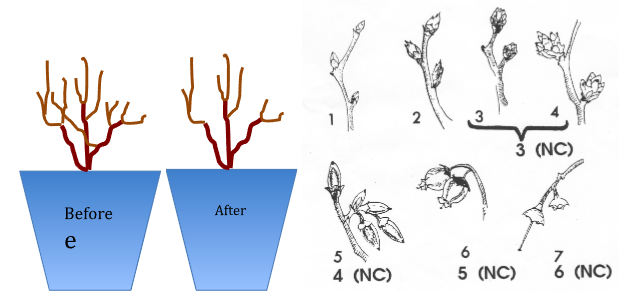In Your Home Garden
Soil:
Blueberries like highly organic, acidic soil and naturally grow near pine trees. Choose a place in your yard that has a sandy loam soil. Really we can work with anything that isn’t CLAY!. Make sure that wherever you chose to plant your blueberry that the soil drains. Bushes will grow to be 3’-5’ tall and about that many feet around. Make sure you don’t plant them too close to structures or other plants. You will need purchase pine mulch to amend the soil around the blueberry bush. It should look like it is chewed up and partially broken down like compost. Avoid bark nuggets that look like they were just stripped off the tree. Dig a hole about the size of a couple gallon plastic bucket. Put a layer of mulch in the hole, then a layer of soil that you dug out of the hole, then more mulch. Then you are 4” from the top of the hole take your plant out of it’s plastic container. Put it in the hole and then continue alternating mulch and soil to fill in the hole and cover the roots. Push down or carefully step around the base of the bush to gently compact the bush down to keep it from popping up out of the ground. You can scatter some more pine mulch around the base of the bush.

Sun:
Blueberries like full sun. Partial sun will be okay if that is all you have.
Water:
Keep the blueberry plant moist not sitting in a puddle. Watering all depends on your location (US climate and microclimate of your yard). Typically when you water your garden is a good time to water your blueberry. If your blueberries are drought stressed they won’t produce a crop or they will produce a small one that can be disfigured.
Fertilizer:
Osmocote is a good slow release fertilizer. Buy Osmocote Flower and Vegetable. Sprinkle 2 T of osmocote on top of the soil/mulch up to 6” from the base of the bush (this area will increase as the bush gets bigger) in early spring (early flowering when day temps are in the 60’s and 70’s (depending on geography this is March to April). Then sprinkle 1 T on top the mulch April to May….about 2 months after your first application. Again put 1T of osmocote on the bushes after harvest (July-ish). This will promote new shoot growth and bud set for next year. You could also use an azalea/rhododendron fertilizer. But be careful to not over fertilize…the salts can burn the roots and kill your plant. Putting another layer of pine mulch around the base of your blueberry every spring will help with fertility as well.
Pruning:
If your bush is actively growing by year three it will need to be pruned and then every year after that. It is best to prune in the winter when they are dormant before they flower. A good time to prune is February in NC and March in northern locations. Cut the branches out with pruners close to another stem or the Crown (center of the plant). You want to remove any branches that cross over other branches. You also want to open up the center to let light into the fruit. If there are dead branches these should be cut out as well. The fruit forms on the top 8-12” of a branch. Over-cropping is a problem and can affect the bush for many years so it is important to prune each winter. It is good to have a nice mix of old and new “canes” or branches. Old canes are thicker and have rough bark….new canes tend to be smooth and red or green in color.

Flowering and fruiting:
Flower buds form the summer before fruit production. Right after a crop is picked the bush will put on leafy growth and set buds before going dormant for the winter. Flower buds form on the top 8-12” of a branch. They are visible and are about the size of a small pea. As the weather warms the buds will swell in the spring. From each bud multiple flowers will emerge. When visible buds form in the spring it is important to watch the weather. If a frost is expected it would be beneficial to cover your bush with a sheet to try and protect the flowers from temperatures below 32. Cover flowers where you can see them starting to separate…stage 3 or 4 to stage 6 in the above graphic. From flower pollination it is about 50-60 days to ripe fruit depending on cultivar and weather.
Overwintering:
You may even need to cover the bush with burlap during the cold winter. The problem is the cold wind and temperatures freezing the water in the tissue and it can’t recover. If it is under snow it insulates the bush and is better.
https://hort.uwex.edu/articles/growing-blueberries-containers
http://www.hort.purdue.edu/ext/HO-65.pdf
http://ohioline.osu.edu/hyg-fact/1000/pdf/1422.pdf
http://www.fallcreeknursery.com/gardeners/gardeners_tips
https://www.rhs.org.uk/advice/grow-your-own/fruit/blueberries